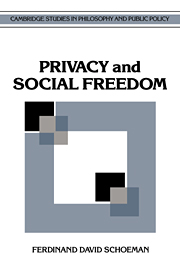Book contents
- Frontmatter
- Contents
- Acknowledgments
- Introduction
- 1 The meaning and scope of privacy
- 2 Mill's approach to social freedom
- 3 Articulated rationality and the Archimedean critique of culture
- 4 Social freedom from the perspective of cognitive and social psychology
- 5 The importance of cultural authority for morality
- 6 Explaining privacy's place
- 7 The ascent of privacy: a historical and conceptual account
- 8 Privacy and gossip
- 9 Privacy and spheres of life
- 10 Spheres of life: a literary exploration
- Epilogue
- Notes
- Index
9 - Privacy and spheres of life
Published online by Cambridge University Press: 23 October 2009
- Frontmatter
- Contents
- Acknowledgments
- Introduction
- 1 The meaning and scope of privacy
- 2 Mill's approach to social freedom
- 3 Articulated rationality and the Archimedean critique of culture
- 4 Social freedom from the perspective of cognitive and social psychology
- 5 The importance of cultural authority for morality
- 6 Explaining privacy's place
- 7 The ascent of privacy: a historical and conceptual account
- 8 Privacy and gossip
- 9 Privacy and spheres of life
- 10 Spheres of life: a literary exploration
- Epilogue
- Notes
- Index
Summary
In this chapter, I introduce the notion of a ‘sphere of life’ as a category of moral analysis, particularly helpful in thinking about privacy. The notion is implicit in what we have already covered. To prepare for this, some review is in order. In Chapter 1, we saw several aspects of personality and intimacy that are protected by institutions and practices of privacy. These include the following: (1) insulation of personal relationships from accountability for social or global ends and norms, (2) protection of individuals from unconditioned exposure of central emotional vulnerabilities, and (3) encouragement of emotional investment in potentially self-expressive roles and relationships.
In Chapter 6, the overall role of privacy was elaborated in social-evolutionary terms. The more vulnerable to extinction one's community, the more extensive will be the range of expected solidarity and interdependence. As expected solidarity and interdependence increase, social pressure increases as well.
As social survival becomes secure, and as flourishing becomes feasible, tolerance for deliberate change increases and, with it, reliance on individual innovation. Functionally focused associations emerge and replace all-embracing associative communities. Individuals become less dependent on the all-embracing community and more dependent on clusters of functionally focused associations. This change deracinates the prospect of monolithic social hegemony.
Individuals experience variable, and to some extent voluntary, sets of involvements that collectively satisfy personal and group needs. Freedom of association evolves as centralized authority degenerates. Individuals as well as groups are liberated to pursue local goals not entirely structured by global community goals.
- Type
- Chapter
- Information
- Privacy and Social Freedom , pp. 151 - 164Publisher: Cambridge University PressPrint publication year: 1992



